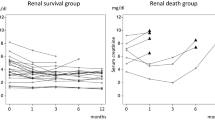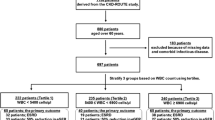Abstract
Elevated eosinophil count was shown to be associated with the development of cholesterol embolization syndrome, a potentially life-threatening condition, after catheter-based procedures. We investigated the association between stages of chronic kidney disease (CKD) and the absolute eosinophil count (AEC) among cardiac patients. CKD stages were determined solely on the estimated glomerular filtration rate or requirement for hemodialysis. Eosinophilia is defined as an eosinophil count exceeding 500/μL. A total of 1022 patients were enrolled in the current study, and eosinophil counts (/μL) in the first through fourth eosinophil count quartiles were <88, 88 to 154, 155 to <238, and 238≤, respectively, and 29 patients (2.8 %) had eosinophilia. Correlation coefficient between the AEC and age was −0.188 (P = 0.001) in women and −0.042 (n.s.) in men (by Spearman’s correlation test). Patients with higher CKD stages had a higher prevalence of the highest AEC quartile or eosinophilia. Logistic regression analysis using severe renal dysfunction (i.e., CKD stage 4 or 5) as the dependent variable, the highest AEC quartile had a significant positive association with an odds ratio of 1.99 (95 % confidence interval, 1.20–3.31, P < 0.01) after adjustment for sex, age, systolic blood pressure, and total white blood cell count. Similarly, after adjustment for the same variables, eosinophilia was associated with severe renal dysfunction with an odds ratio of 2.60 (95 % confidence interval, 1.08–6.26, P < 0.05). Eosinophil count was positively associated with higher CKD stages among cardiology patients, some fraction of which might be related to subclinical cholesterol embolization.


Similar content being viewed by others
References
Hasegawa M, Ishii J, Kitagawa F, Kanayama K, Takahashi H, Ozaki Y, Yuzawa Y (2013) Prognostic value of highly sensitive troponin T on cardiac events in patients with chronic kidney disease not on dialysis. Heart Vessels 28:473–479
Takaya Y, Yoshihara F, Yokoyama H, Kanzaki H, Kitakaze M, Goto Y, Anzai T, Yasuda S, Ogawa H, Kawano Y (2014) Impact of onset time of acute kidney injury on outcomes in patients with acute decompensated heart failure. Heart Vessels. doi:10.1007/s00380-014-0572-x
Kronzon I, Saric M (2010) Cholesterol embolization syndrome. Circulation 122:631–641
Saric M, Kronzon I (2011) Cholesterol embolization syndrome. Curr Opin Cardiol 26:472–479
Fukumoto Y, Tsutsui H, Tsuchihashi M, Masumoto A, Takeshita A (2003) The incidence and risk factors of cholesterol embolization syndrome, a complication of cardiac catheterization: a prospective study. J Am Coll Cardiol 42:211–216
Ramirez G, O’Neill WM Jr, Lambert R, Bloomer HA (1978) Cholesterol embolization: a complication of angiography. Arch Intern Med 138:1430–1432
Quinones A, Saric M (2013) The cholesterol emboli syndrome in atherosclerosis. Curr Atheroscler Rep 15:315
Matsuo S, Imai E, Horio M, Yasuda Y, Tomita K, Nitta K, Yamagata K, Tomino Y, Yokoyama H, Hishida A (2009) Revised equations for estimated GFR from serum creatinine in Japan. Am J Kidney Dis 53:982–992
Levey AS, Eckardt KU, Tsukamoto Y, Levin A, Coresh J, Rossert J, De Zeeuw D, Hostetter TH, Lameire N, Eknoyan G (2005) Definition and classification of chronic kidney disease: a position statement from kidney disease: improving global outcomes (KDIGO). Kidney Int 67:2089–2100
Fauci AS, Harley JB, Roberts WC, Ferrans VJ, Gralnick HR, Bjornson BH (1982) NIH conference. The idiopathic hypereosinophilic syndrome. Clinical, pathophysiologic, and therapeutic considerations. Ann Intern Med 97:78–92
Machino-Ohtsuka T, Seo Y, Ishizu T, Sekiguchi Y, Sato A, Tada H, Watanabe S, Aonuma K (2010) Combined assessment of carotid vulnerable plaque, renal insufficiency, eosinophilia, and hs-CRP for predicting risky aortic plaque of cholesterol crystal embolism. Circ J 74:51–58
Hospers JJ, Rijcken B, Schouten JP, Postma DS, Weiss ST (1999) Eosinophilia and positive skin tests predict cardiovascular mortality in a general population sample followed for 30 years. Am J Epidemiol 150:482–491
Hospers JJ, Schouten JP, Weiss ST, Postma DS, Rijcken B (2000) Eosinophilia is associated with increased all-cause mortality after a follow-up of 30 years in a general population sample. Epidemiology 11:261–268
Date A, Jacob M, Johny KV (1977) Eosinophilic leukocytes in diffuse proliferative and exudative glomerulonephritis. Am J Trop Med Hyg 26:1028–1031
Gabizon D, Kaufman S, Shaked U, Evans SY, Modai D (1981) Eosinophilia in uremia. Nephron 29:36–39
Diskin CJ, Stokes TJ, Dansby LM, Radcliff L, Carter TB (2011) The prevalence and meaning of eosinophilia in renal diseases on a nephrology consultation service. Nephrol Dial Transplant 26:2549–2558
Sjogren U, Thysell H (1977) Bone marrow morphology in patients on regular haemodialysis treatment. Acta Haematol 58:332–338
Hertel J, Kimmel PL, Phillips TM, Bosch JP (1992) Eosinophilia and cellular cytokine responsiveness in hemodialysis patients. J Am Soc Nephrol 3:1244–1252
Kojima K, Oda K, Homma H, Takahashi K, Kanda Y, Inokami T, Uchida S (2005) Effect of vitamin E-bonded dialyzer on eosinophilia in haemodialysis patients. Nephrol Dial Transplant 20:1932–1935
Kato A, Ohtsuji A, Terada T, Goto T, Fukasawa H, Yasuda H, Togawa A, Fujimoto T, Suzuki H, Fujigaki Y, Yamamoto T, Yonemura K, Hishida A (2002) Recovery from hemodialysis therapy in a patient with renal cholesterol crystal embolism. Nephron 92:240–243
Kawakami T, Fujita A, Takeuchi S, Muto S, Soma Y (2009) Drug-induced hypersensitivity syndrome: drug reaction with eosinophilia and systemic symptoms (DRESS) syndrome induced by aspirin treatment of Kawasaki disease. J Am Acad Dermatol 60:146–149
Teragaki M, Kawano H, Makino R, Inoue K, Sai Y, Hosono M, Suehiro S, Okamura M (2012) A case of warfarin-induced eosinophilia. Intern Med 51:1627–1629
Ishizaka N, Ishizaka Y, Toda E, Shimomura H, Koike K, Seki G, Nagai R, Yamakado M (2008) Association between cigarette smoking and chronic kidney disease in Japanese men. Hypertens Res 31:485–492
Noborisaka Y (2013) Smoking and chronic kidney disease in healthy populations. Nephrourol Mon 5:655–667
Fukui M, Tanaka M, Hamaguchi M, Senmaru T, Sakabe K, Shiraishi E, Harusato I, Yamazaki M, Hasegawa G, Nakamura N (2009) Eosinophil count is positively correlated with albumin excretion rate in men with type 2 diabetes. Clin J Am Soc Nephrol 4:1761–1765
Funabiki K, Masuoka H, Shimizu H, Emi Y, Mori T, Ito M, Nakano T (2003) Cholesterol crystal embolization (CCE) after cardiac catheterization: a case report and a review of 36 cases in the Japanese literature. Jpn Heart J 44:767–774
Acknowledgments
We are highly appreciative of Chieko Ohta, Yumiko Ohgami, and Megumi Hashimoto for their excellent technical assistance. The authors received no specific funding for this work.
Conflict of interest
The authors declare that they have no conflict of interest.
Author information
Authors and Affiliations
Corresponding author
Rights and permissions
About this article
Cite this article
Ishii, R., Fujita, Si., Kizawa, S. et al. Association between absolute blood eosinophil count and CKD stages among cardiac patients. Heart Vessels 31, 198–205 (2016). https://doi.org/10.1007/s00380-014-0590-8
Received:
Accepted:
Published:
Issue Date:
DOI: https://doi.org/10.1007/s00380-014-0590-8




